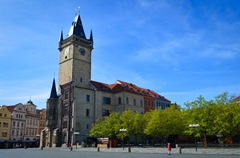Written by: Aiman Javed
Posted on: March 30, 2018 |  | 中文
| 中文
Shakil Saigol's 'And they handcuffed the flowers...'
Shakil Saigol’s solo exhibition opened at the Tanzara Gallery, Islamabad, last evening. As visitors flocked to the opening, Nosheen Qadir, owner and curator welcomed them. With figurative and surrealistic works, the 13 canvases in the exhibition were bound together by the concept, ‘Abhinaya: An Alphabet of Ecstasy and Anguish.’ Abhinaya is an integral part of Indian classical dance; it is the process through which the dancer leads the audience to experience any particular sentiment.
Through his statement, the artist provides context for how the series came about, narrating joyous childhood summers spent in Lahore, oftentimes observing traditional dance performances at the annual music festival. According to Nosheen Qadir, “Characterized by strong metaphors, imagery and intricately worked canvases, Saigol’s work exudes both boldness and fragility. In works like this, the artist captures fleeting emotions and ephemeral instances of his feelings, with a lucidity that stems from his highly developed skill and technique. ”
Upon entering the gallery, one is met with four canvases showcasing poses from Bharatnatyam. The dancers pose in bright traditional saris, each espousing a different abhinaya. The canvas on ‘Raag Shankara’ depicts the poetic stylization involved in Natyadharmi Abhinaya; within which a codified manner is followed for presenting emotions and expressions. The dancer in ‘Raag Des’ depicts Angika Abhinya; showing the expressive movement of limbs. The dancers in Raag Kalavati and Raag Durga, reflected Vachika Abhinaya, which essentially means that speech and song (such as mouthing the words) are utilized. The largest painting of the exhibition, a triptych, showcased the Raag Darbari in Tarana, consisting of Bharatnatyam poses. In this case, the expressed abhinaya was the Aharya Abhinaya, which focuses on the costume and setting of the dancer. One look at the painting clarifies this, as the various poses of the dancer are showcased in the courtyard of a grandiose Mughal monument.
You may also like:

The Changing Landscape of Children's Festivals in Pakistan: Featuring Lahore Children's Festival
(November 26, 2024)

Centers of No Attention: Comparing Pakistan's City Centers with European Squares
(November 22, 2024)